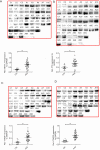Increased m6A methylation level is associated with the progression of human abdominal aortic aneurysm
- PMID: 32042813
- PMCID: PMC6989874
- DOI: 10.21037/atm.2019.12.65
Increased m6A methylation level is associated with the progression of human abdominal aortic aneurysm
Abstract
Background: The role of N6-methyladenosine (m6A) modification in abdominal aortic aneurysm (AAA) has not been extensively studied. This study therefore aimed to investigate m6A RNA methylation and the expressions of the corresponding modulators in AAA.
Methods: A comparative study between AAA tissue samples (n=32) and healthy aortas (n=12) was performed using m6A methylation quantification for messenger RNA (mRNA) m6A status, quantitative polymerase chain reaction (qPCR), and western blot for the expressions of m6A modulators and immunohistochemistry (IHC) to detect locations of the modulators in AAA tissues.
Results: The m6A level significantly increased in AAA as compared to healthy aorta tissues. Among AAA patients, the high m6A level represented an even greater risk of AAA rupture as compared to non-ruptured AAA [odds ratio (OR), 1.370; 95% confidence interval (CI), 1.007-1.870]. The major N6-adenosine modulators, including YTHDF1, YTHDF3, FTO, and METTL14, are the main factors involved in aberrant m6A modification and the expression of both was significantly correlated to the proportion of m6A in total mRNA. Clinically, YTHDF3 represented an even greater risk of rupture (OR, 1.036; 95% CI, 1.001-1.072). Regarding the cellular location, METTL14 seemed to be associated with inflammatory infiltrates and neovascularization. Furthermore, a strong correlation was seen between FTO and aneurysmal smooth muscle cells (SMCs), YTHDF3, and macrophage infiltrate.
Conclusions: We were first to observe m6A modification in human AAA tissues. The results also reveal the important roles of m6A modulators, including YTHDF3, FTO, and METTL14, in the pathogenesis of human AAA and provide a new view on m6A modification in AAA. Our findings suggest a potential mechanism of epigenetic alterations in clinical AAA.
Keywords: Abdominal aortic aneurysm (AAA); N6-methyladenosine RNA methyltransferase (m6A RNA methyltransferase); N6-methyladenosine modification (m6A modification); epigenetics.
2019 Annals of Translational Medicine. All rights reserved.
Conflict of interest statement
Conflicts of Interest: The authors have no conflicts of interest to declare.
Figures






Similar articles
-
METTL3-METTL14 complex induces necroptosis and inflammation of vascular smooth muscle cells via promoting N6 methyladenosine mRNA methylation of receptor-interacting protein 3 in abdominal aortic aneurysms.J Cell Commun Signal. 2023 Sep;17(3):897-914. doi: 10.1007/s12079-023-00737-y. Epub 2023 Mar 22. J Cell Commun Signal. 2023. PMID: 36947363 Free PMC article.
-
Expression Pattern and Clinical Value of Key m6A RNA Modification Regulators in Abdominal Aortic Aneurysm.J Inflamm Res. 2021 Aug 29;14:4245-4258. doi: 10.2147/JIR.S327152. eCollection 2021. J Inflamm Res. 2021. PMID: 34511965 Free PMC article.
-
Bioinformatic analyses of the role of m6A RNA methylation regulators in abdominal aortic aneurysm.Ann Transl Med. 2022 May;10(10):547. doi: 10.21037/atm-22-1891. Ann Transl Med. 2022. PMID: 35722410 Free PMC article.
-
The role of m6A methylation in abdominal aortic aneurysms: Mechanisms, progress and future perspectives (Review).Mol Med Rep. 2025 Jul;32(1):199. doi: 10.3892/mmr.2025.13564. Epub 2025 May 16. Mol Med Rep. 2025. PMID: 40376996 Free PMC article. Review.
-
Epigenetic regulation of mRNA N6-methyladenosine modifications in mammalian gametogenesis.Mol Hum Reprod. 2021 May 8;27(5):gaab025. doi: 10.1093/molehr/gaab025. Mol Hum Reprod. 2021. PMID: 33823008 Review.
Cited by
-
The role of M6A modification in the regulation of tumor-related lncRNAs.Mol Ther Nucleic Acids. 2021 Apr 9;24:768-779. doi: 10.1016/j.omtn.2021.04.002. eCollection 2021 Jun 4. Mol Ther Nucleic Acids. 2021. PMID: 33996258 Free PMC article. Review.
-
Novel insight of N6-methyladenosine modified subtypes in abdominal aortic aneurysm.Front Genet. 2022 Nov 22;13:1055396. doi: 10.3389/fgene.2022.1055396. eCollection 2022. Front Genet. 2022. PMID: 36482903 Free PMC article.
-
The abdominal aortic aneurysm-related disease model based on machine learning predicts immunity and m1A/m5C/m6A/m7G epigenetic regulation.Front Genet. 2023 Feb 23;14:1131957. doi: 10.3389/fgene.2023.1131957. eCollection 2023. Front Genet. 2023. PMID: 36911406 Free PMC article.
-
N1-Methyladenosine (m1A) Regulation Associated With the Pathogenesis of Abdominal Aortic Aneurysm Through YTHDF3 Modulating Macrophage Polarization.Front Cardiovasc Med. 2022 May 10;9:883155. doi: 10.3389/fcvm.2022.883155. eCollection 2022. Front Cardiovasc Med. 2022. PMID: 35620523 Free PMC article.
-
The role of m6A in angiogenesis and vascular diseases.iScience. 2024 May 23;27(7):110082. doi: 10.1016/j.isci.2024.110082. eCollection 2024 Jul 19. iScience. 2024. PMID: 39055919 Free PMC article. Review.
References
-
- Hirsch AT, Haskal ZJ, Hertzer NR, et al. ACC/AHA 2005 Practice Guidelines for the management of patients with peripheral arterial disease (lower extremity, renal, mesenteric, and abdominal aortic): a collaborative report from the American Association for Vascular Surgery/Society for Vascular Surgery, Society for Cardiovascular Angiography and Interventions, Society for Vascular Medicine and Biology, Society of Interventional Radiology, and the ACC/AHA Task Force on Practice Guidelines (Writing Committee to Develop Guidelines for the Management of Patients With Peripheral Arterial Disease): endorsed by the American Association of Cardiovascular and Pulmonary Rehabilitation; National Heart, Lung, and Blood Institute; Society for Vascular Nursing; TransAtlantic Inter-Society Consensus; and Vascular Disease Foundation. Circulation 2006;113:e463-654. - PubMed
-
- Erbel R, Aboyans V, Boileau C, et al. 2014 ESC Guidelines on the diagnosis and treatment of aortic diseases: document covering acute and chronic aortic diseases of the thoracic and abdominal aorta of the adult. The Task Force for the Diagnosis and Treatment of Aortic Diseases of the European Society of Cardiology (ESC). Eur Heart J 2014;35:2873-926. 10.1093/eurheartj/ehu281 - DOI - PubMed
-
- Han YS, Zhang J, Xia Q, et al. A comparative study on the medium-long term results of endovascular repair and open surgical repair in the management of ruptured abdominal aortic aneurysms. Chin Med J (Engl) 2013;126:4771-9. - PubMed
LinkOut - more resources
Full Text Sources
